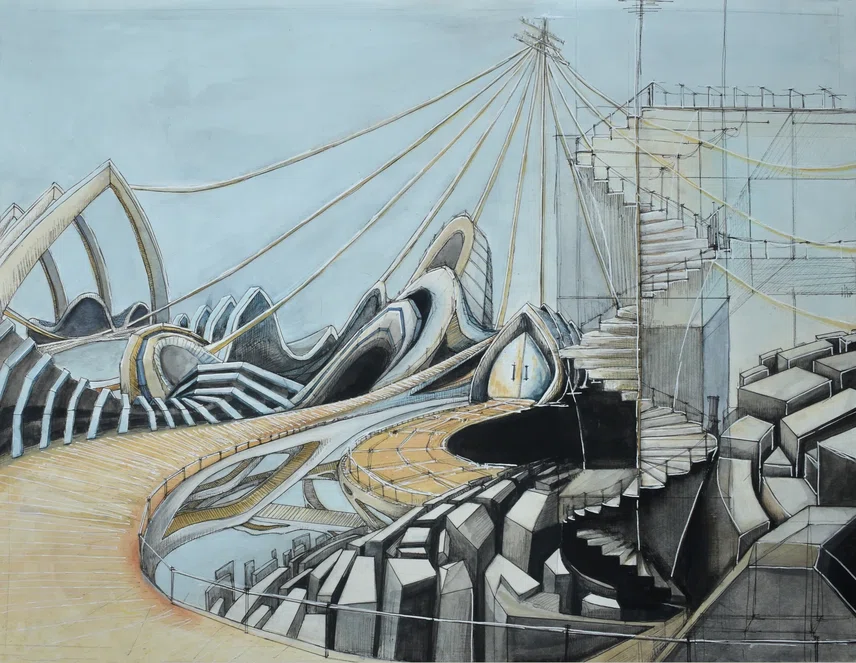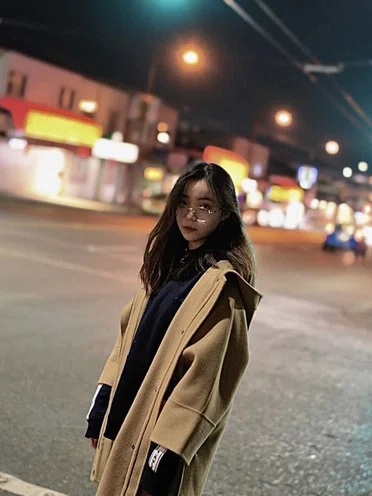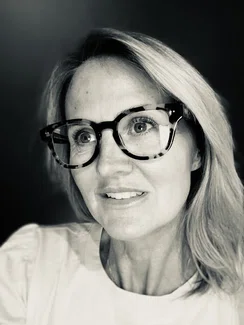







2-D Design
Lu Peng
Sentinel Secondary School|West Vancouver, British Columbia

Untitled|13 x 17 in.
Material(s): Pen for form and outline, watercolour/ink for form/value, portraying hue/tone
Process(es): Revision of all past investigations, modeled into cityscape plane - projected into surreal space
Curatorial Note: Powerful example of architectural research


“How can natural form influence architecture? To begin my inquiry, I observed various natural forms. Further questions arose: how can organic forms be portrayed through contemporary architecture? Inspired by the architectural works of Zaha Hadid & Roman Vlasov, I explored the pattern & formation in natural forms.”

Student statement
Student
statement
As a resident growing up in the urban cities of Canada and China, I have been highly conscious of the surrounding landscape and architecture. I became mesmerized by the organic structures in contemporary architecture. This interest inspired me to build my portfolio on the topic of natural form’s interrelationship with architecture.
The selected artworks explore the progression of my idea: I first observed an organic shape of an oyster shell. The natural uneven curvatures of the shells conjure a strong shelter for the invertebrates, and I thought - how can I incorporate this aspect into architecture? I experimented with lines, creating rhythmic movement, and synthesized relative materials like wood, plaster paste, and resin to create an interconnection to architecture. I then interwove the curved shape of the oyster into structural elements through layers of tracing and nomograph paper, creating further connections into geometric architectural designs. In the end, inspired by many different natural forms, my research and experimentation ultimately manifest into a culmination of a final revision of a surreal urban cityscape.

Lu Peng

Oyster Architectural Design Revision|13 x 18.5 in.
Material(s): Nomograph print, collage/tracing paper = layering/transparency, charcoal = depth, pen for highlight
Process(es): Revised lines and contrasting values create one-point perspective, forming to surreal architecture
Curatorial Note: Powerful example of architectural research
I am super thankful to my art teacher, Mrs.Hambly, for taking so much of her time, in and out of class, to help guide us through the portfolio. She opens the art studio every day and always encourages us to explore new ideas and materials through research and hands-on demonstrations. She provided us with knowledge, inspiration, and confidence to complete our portfolios.
My advice to AP students is that if you feel lost or in self-doubt, don't stop creating art, keep experimenting with materials and new concepts! For me, experimentation brought many new innovations, which I later incorporated into my portfolio.
Teacher Statement
Teacher Statement
Madelyn Hambly

Lu Peng is a dedicated and innovative art student who can take an idea and skillfully see it through to its end; she does not give up until all possible design considerations and concepts have been addressed. Lu is always open to critique and discourse, and as a result, her work consistently evolves throughout the revision process.
Material(s): Modelled plaster paste and UV resin on wood for texture, gesso/acrylic for solidity and pattern.
Process(es): Experimentation with material and texture integrating wave patterns to conceptual building framework
Curatorial Note: Powerful example of architectural research
Lu’s journey to AP Art and Design started early at Sentinel Secondary within our foundational art classes and then our Pre-AP Art courses. The scaffolding of the courses provided Lu with strong fundamentals to start her portfolio with the importance of understanding research, exploration, and experimentation to achieve synthesis of materials and ideas. Within the classroom, I encourage my students to take artistic risks by experimenting with unfamiliar materials and concepts. This process allows the students to freely create through varying surfaces and materials with their mark-making processes. In gallery settings, we continuously explore historical, conceptual, and contemporary artists and question the artist's choice of materials and ideas. Our group critiques are structured around the AP rubric, where students discuss and write about their material and process with every piece they create. This helps them to articulate their ideas within the AP Art and Design course framework.
Sentinel Secondary offers a diverse visual learning community that is very supportive in offering a wide range of elective courses at every grade level to support Art Education and Applied Design Skills and Technology. These courses lead to students taking AP 2-D, AP 3-D, and AP Drawing. Sentinel also offers instruction outside of classroom hours to provide valuable time for students to complement their classroom learning.

Lu Peng














